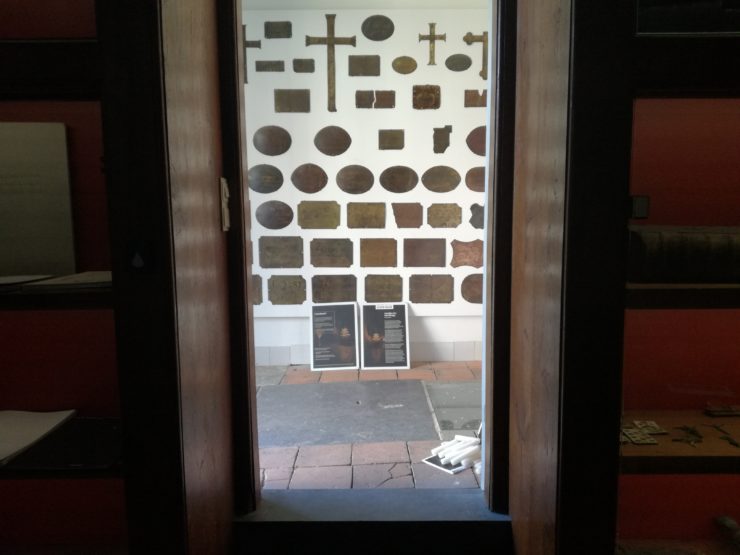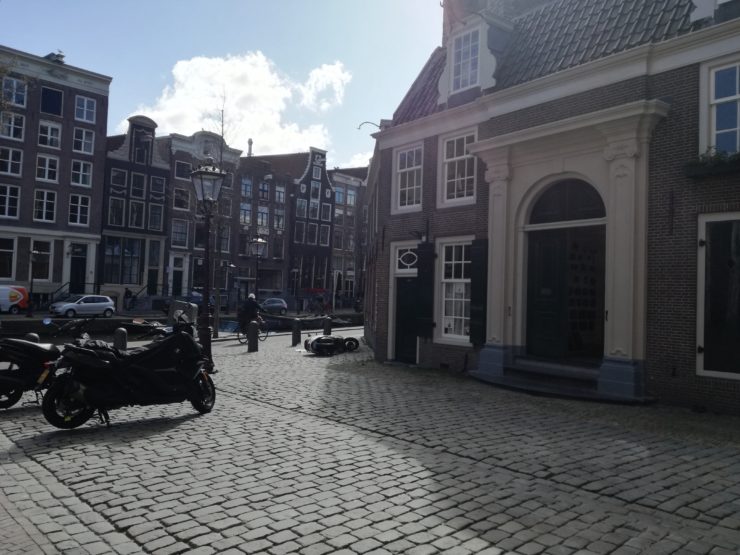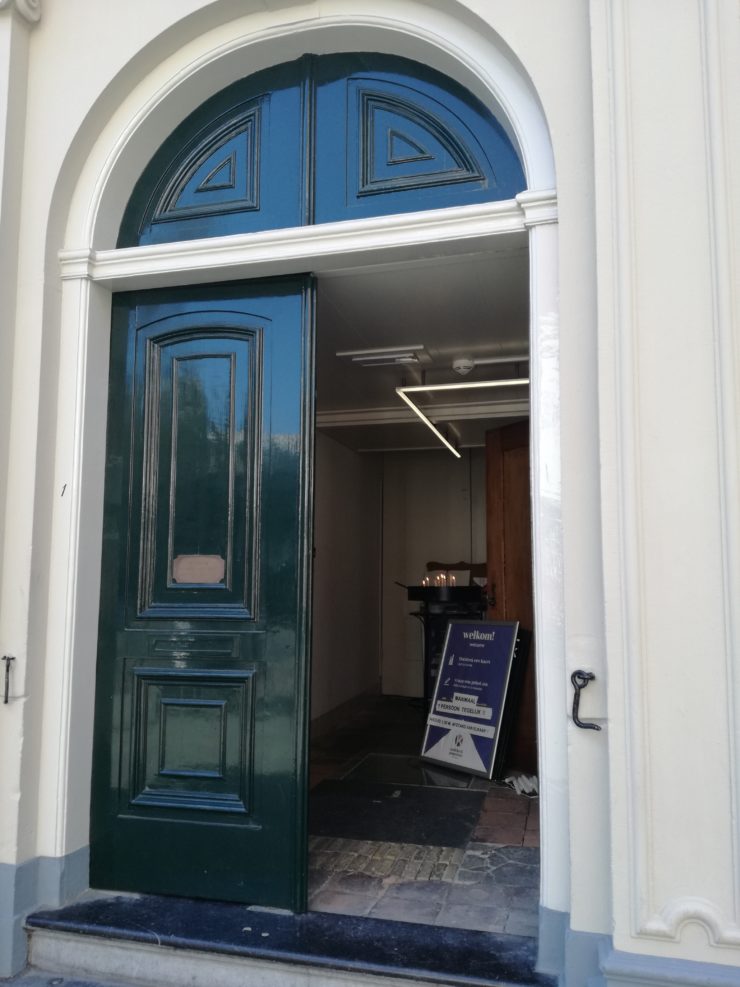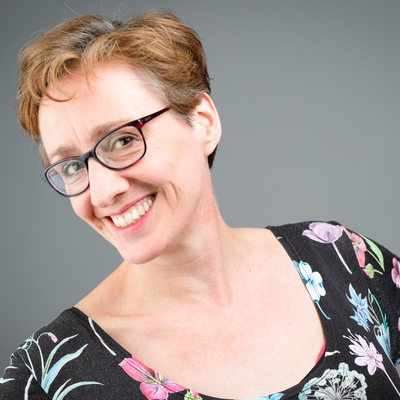Candles for Earthlings & The World After
Elza Kuyk
The railway journey from Amersfoort to Amsterdam is a quiet one. There is a cold wind this Sunday afternoon, the 29th of March. I find my way to an improvised chapel of the Oude Kerk where I take one of the four shifts as ‘kerkwacht’ (church guardian) on behalf of the church community. On Wednesday the same is done by the Oude Kerk (foundation).[1] The church building is an example of multiple used church buildings in the Netherlands which host a worshipping (protestant) community while ownership of the building is in the hands of a foundation. De Oude Kerk has a particular profile in this field with some outspoken art exhibitions (see my previous blogs in English – here – and Dutch – here, and interviews, in Dutch, with ND and De Groene Amsterdammer).
Between 10h and 18h people can enter and light a candle or write a message in a guest or prayer book. Next to the small room is another small room, the library, where the ‘kerkwacht’ can keep a safe distance from incoming visitors and yet remain in contact.

The Oude Kerk website explains this initiative called Candles for Earthlings:
“Art and religion offer hope in times of crisis. But how do we stay connected in this time of quarantine now that places like churches and museums have closed their doors? The Oude Kerk and the Oude Kerk congregation jointly present the initiative Candles for Earthlings. Lighting a candle for someone is a centuries-old tradition that offers solace in uncertain times both in churches and beyond. In recent months, we lit 120 candles in the Oude Kerk every day as part of the art installation Poems for Earthlings by Adrián Villar Rojas. We salvaged the candle stumps that were left over at the end of the day, because the artist considered it important that the materials were recycled.
Poems for Earthlings is about art in times of crisis – a theme that is suddenly more topical than we would like it to be. More than ever, we Earthlings are now connected worldwide.
It is uncertain whether the Villar Rojas exhibition will ever be open to the public again. Nor do we know when we will be able to congregate in the Oude Kerk again. To stay connected and keep the fire of faith and art burning we have decided to give the Poems for Earthlings candles a second life. We will hand them out in the neighbourhood and people can pick them up at the Oude Kerk.
It is certain that the world will change because of this crisis. We hope that change will be positive. What do you hope the world will look like after this period? (bold in original EK) Light your candle at home, take a picture of it, add your personal wish, send it to us and we will share it with the world.
Do you want to join in? You can pick up a candle at the Oude Kerk on Sundays and Wednesdays. Light your candle, take a picture and, together with your short answer to the question: ‘How do you hope the world will change because of this crisis?’, send it to info@oudekerk.nl or share it on social media tagging your post with the hashtag #CandlesforEarthlings. If you cannot come to the Oude Kerk to pick up a candle, you are of course very welcome to join in using your own. – Naturally, we will consistently implement the RIVM[2] hygiene measures during this initiative.”
The initiative Candles for Earthlings started on the 22nd of March as a common enterprise of the Oude Kerk (foundation) and the Oude Kerk congregation: “Art and religion offer hope in times of crisis”. The common effort is expressed on a leaflet: “By sharing candles, we keep the fire of faith and art alive.”[3] Faith and art are put in an equal position to reflect on what we “hope the world will look like after this period”.
There are tensions, however, between the Oude Kerk (foundation) and others, including the Oude Kerk congregation. But at some points, a common concern can lead to a common action like Candles for Earthlings. An example of a previous collaboration was a common statement as a response to the Nashville Declaration of 9 January 2019.
Did the Oude Kerk facilitate lighting small candles before the Corona-crisis? During the regular opening hours of the Oude Kerk the former baptismal chapel offered a place for lighting small candles. The possibility was offered as long as exhibitions allowed for it. During some of the last exhibitions this chapel was not accessible, and lighting small candles was not possible. The use of candles has always been part of the Christian liturgy in the Oude Kerk; foremost the Easter candle, but next to that, the personal lighting of a small candle is usually possible in or around (for instance before entering) the Oude Kerk worship services.
Responding to the Corona outbreak this seems a natural thing to do. The appeal to light a candle at home and express thoughts about the question “how the world will look like after this period” is expressed by the Oude Kerk (foundation), but not explicitly by the church congregation. The explicit relationship with the exhibition is not equally obvious for the congregation. The congregation has other ways to reach out to society and show care and solidarity.
Kerkwacht 14-16h, 29 March 2020
The door that leads to the church needs some fortification as the incoming wind manages to open it by itself and to sweep the holder of the book to the ground. Inside the church are helpful materials that can serve that purpose.
About eight people come by during my two-hour shift. One or two want to see more of the church. I recommend them to visit the Oude Kerk in better times to come. All of them are thankful to be able to light a candle. The first two start to talk to me while they are outside: they want to pay electronically, but I respond that no fee is requested (a voluntary gift is always possible and welcome, but I forget to mention that). ”Please come, feel free”; I ask them to come in.
Not many of them would realize that the small room is filled with references to death and past generations. Beneath them are bones of deceased in the ‘knekelput’ (bones pit), collected when graves were lifted to create room in the church graves. The wall is covered with copper signs containing the names of a number of persons who died before burying in churches was forbidden (mid 19th-century). Most of the visitors only came in for a short moment of time. One visitor, however, who introduced himself as a man of 62 years old, took the seat behind the closed half of the front door and talked to me for almost an hour. About his life, reading parts out of history and psychology magazines that he considered interesting to share with me, talking about several things he would do tomorrow ‘first thing in the morning’, offering to clean the copper plates (I can hardly keep myself from shouting ”o please, don’t” – but the man is just talking on), searching among the names for anyone with his family name, and so on. I asked him to interrupt his stories and to make room, in case anyone else wanted to come in. He did, and at a certain point I decided it was time for him to sit in the sun.
The last visitor who came in was a person to enjoy: a young guy with a baseball cap, who came in stating that he was not a believer. Second statement: he was very bored. He was on Dam Square where ‘many’ people were gathered: eleven persons. It made him start to walk around and he noted this door to be open. He was happy to write something in the guest book, while chatting with me in short questions and answers. I guess he lit a candle as well.
The next ‘kerkwacht’ and I had a chat about the church audio-service that both of us had listened to in the morning. He noticed that the picture on the website of the Oude Kerk, which showed the pastor and two church musicians in the high choir of the Oude Kerk while recording the audio service, added something important to him. These days many pastors and church musicians make efforts to work on worship services online. It looks as if quite a bit of the liturgy gets lost in these efforts. We miss church bells, the church building, the visuals, the communion. With that final reflection, I have just enough minutes to catch the train. And I forget to take a candle with me.

The World After
The Oude Kerk continues with a new programme, launched on the 30th of March, following the theme of the exhibition, called ‘The World After: Time for a Common View on the Future’ (all English translations by the author).[4]
As a cultural and religious institution the Oude Kerk shares the fate of all multiple used church buildings: closed for meetings, facing loss of income, continued costs, worries about employees, etc. In this church building religion and art respond to a similar task in present society and have similar ‘things to offer’. “Besides isolation and limitations this situation goes along with inspiration and mental space. In a vision with the title The World After we take time to reflect and look into the future. What will the Antropocene look like after Covid-19?”[5]
“At home I made a sort of little altar: a picture of the work (Poems for Earthlings, EK) with a candle. With the pastor of the Oude Kerk congregation I discuss what it means for us as an art institution and for her as member of a faith community to be present for people in times of social distancing. There is an obvious need to attribute meaning in this situation. We both feel that art and religion matter more than ever. The exhibition of Adrián Villar Rojas has an almost prophethic power, even – or maybe more – as a memory.”
– Jacqueline Grandjean, director and curator Oude Kerk[6].
There is no easy comfort. The approach can be connected to an article by Ramsey Nasr: “In times of Corona art offers support by stumbling along”.[7] Nasr refers to the common refences to art as a source for beauty and comfort in times of crisis. Literature, poetry and other forms of art enjoy a new interest but often in a rather utilitarian way. He stresses something else: art is an expression of unease and resilience, and it can be appalling. It can confront us with our dark sides which we we tend to hide or forget about in daily life. Art shows us the complexity of life. He also reflects on the apparent meaninglessness of art. It is precisely this, that turns out to be meaningful.
And this too, can be said of religion. Offering other perspectives, the texts and artefacts of a religious tradition remind us how previous generations, biblical figures, people in other times of history, people in a broad variety of social and economic circumstances, dealt and deal with the vulnerability of life and the question whether God is involved and, if yes, how. In celebrating liturgy these questions usually find expression. In Christian liturgy they do so as well: in psalms, gestures, prayers, silence, music, contemplation, share of joy and sorrow and in sacraments, references are made to Christian sources and traditions in enacting it. Liturgy is fixed and free in a particular mixture. Like art, it aims to provide a perspective both within and beyond daily life.
Meaning, or for that matter, meaninglessness, is sometimes also mentioned as a characteristic of (old) church buildings themselves. They can be seen as spaces without meaning; spaces without a very obvious meaning; without a single, straightforward meaning; or, if they have a meaning of some kind at all, it may well be a very layered meaning. A church building provides a space different than the outside world surrounding it. If offers another sense of time and another sense of being in the universe.
I expect that the re-opening of this kind of places will enjoy renewed interest in The World After.

Notes
[1] The Oude Kerk (foundation) presents itself as Oude Kerk without ‘foundation’ but it is mentioned here as such in order to distinguish it from the Oude Kerk congregation. The official name is Stichting de Oude Kerk te Amsterdam. On Twitter the reference is OudeKerkAMS.
[2] RIVM: National Institute for Public Health and the Environment.
[3] Door deze kaarsen uit te delen, houden we het vuur van geloof en kunst brandend. (Translation EK)
[4] The World After: Tijd voor een gezamenlijke blik op de toekomst. (translation EK). The description of The World After is presently only available in Dutch. The programme is a collaboration with Mister Motley. More information and first examples can be found on the website.
[5] Naast isolement en beperkingen brengt deze situatie ook inspiratie en geestelijke ruimte. In een visioen met de titel The World After nemen we samen de tijd om stil te staan en de toekomst in te kijken. Hoe ziet het Antropoceen van na COVID-19 eruit? (translation EK)
[6] Thuis heb ik een soort altaartje gemaakt: een foto van het werk met een kaars erbij. Met de dominee van de Oudekerkgemeente bespreek ik wat het voor ons als kunstinstelling en voor haar als geloofsgemeente betekent om er te zijn voor mensen in tijden van sociale afstand. De behoefte om betekenis te geven aan deze situatie is groot. We hebben beiden het gevoel dat kunst en religie er meer toe doen dan ooit. De tentoonstelling van Adrián Villar Rojas heeft daarin een haast profetische kracht. Zelfs – of juist – als herinnering. (translation EK) For more reflections, click here.
[7] In tijden van corona biedt kunst houvast door mee te wankelen (translation EK). NRC, essay Rasey Nasr, April 1st, 2020.
All photos by the author (March 2020)
This blog is a part of ‘Dossier Corona’, introduced by Religious Matters in the spring of 2020.

